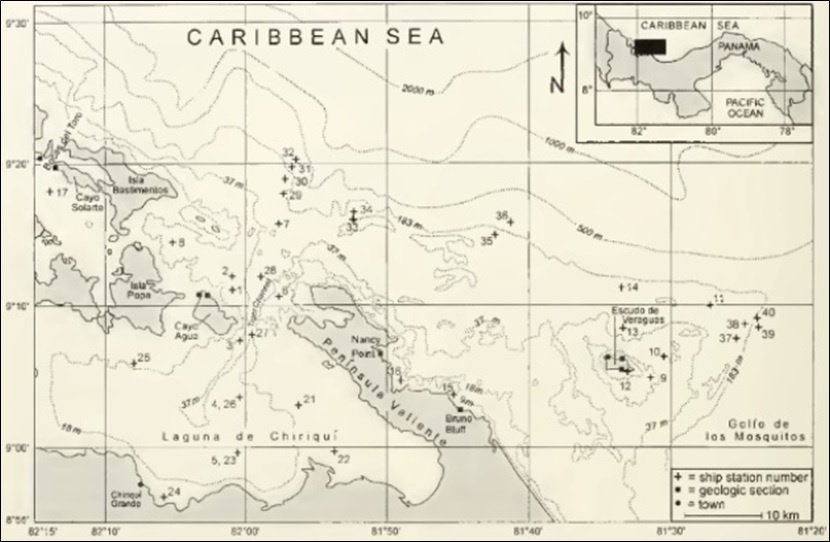Old Bank Fm
Type Locality and Naming
The Old Bank Fm crops out extensively in the southern half of Colon Island (Figure 041; Figure 042) where it is crossed by the Bocas del Drago road along which there are several good exposures. It also occurs in the northeast of the island where it forms a distinct escarpment parallel to the coast. Many streams have waterfalls where they cross this scarp with good exposures. The same unit crops out on Bastimentos Island (Figure 041; Figure 042). There are exposures from Juan Brown Point eastwards along, and inland of the south coast, in steep stream courses flowing down from the ridge formed by its outcrop, which parallels the coast (Coates et al. (2005)).
Synonym: Isla Solarte Fm
Lithology and Thickness
On Colon Island the Old Bank Unit consists mostly of a blue-grey mudstone with occasional thin sandstone stringers, fine volcanic conglomerate and volcanic boulder beds. On Bastimentos, it may be micaceous and sandier, with wood fragments and sparse mollusks including turritellids and Anadara. Preliminary field observations suggest it is an inner shelf deposit flanking volcanic islands and that it is about 3.5-2.0 Ma (Coates et al. (2005)). The Fish Hole Member outcrops on the northeastern rim of Bastimentos (Figure 042) and consists of ~4 m of thick-bedded, rubbly, bioclastic, limestone containing volcanic sand and silt grains in varying amounts. Pristine shells collected from within the reef unit (Figure 117) of the Fish Hole Member provide strontium isotope ages ranging from 5.8 to 5.6 Ma. (Messinian) (Klaus et al. (2012)).
Thickness: N/A
Relationships and Distribution
Lower contact
Upper contact
Regional extent
GeoJSON
Fossils
Stylophora minor: https://nmita.rsmas.miami.edu,
Dichocoenia eminens: https://fi.pinterest.com
Placocyathus costatus: https://nmita.rsmas.miami.edu
Figure 117. Modern equivalent of corals from the Fish Hole Mbr of the Old Bank Fm. Information from Klaus et al. (2012).
Age
Depositional setting
Additional Information
References:
- Canu & Bassler (1928). Describe Bryozoans from the Minnitimmi Creek, Almirante Bay in Isla Colon which is most likely from the Old Bank Fm (Figure 042) [see also “Minitimi Limestone”]
- Ingram (1939); Coates et al. (2005); Klaus et al. (2012) ;

 Location map Fig_042_Left.jpg)